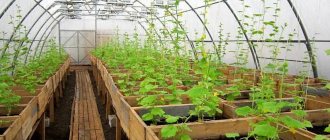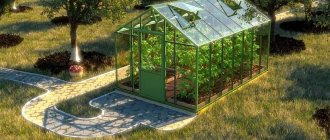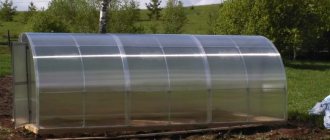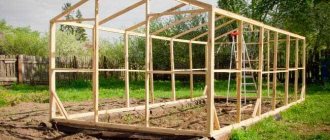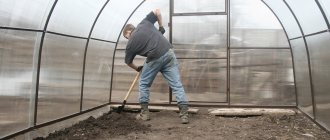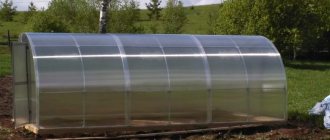Properly selected soil is the key to a good harvest. Therefore, every gardener should know what soil to choose for a greenhouse. Greenhouse soil can be purchased without problems in specialized stores. It is sold in bags and contains all the necessary microelements for the normal growth of greenhouse plants. However, not everyone can afford such a purchase, especially if the greenhouse area is large enough. Therefore, many summer residents prefer to prepare the soil for greenhouses themselves. Let's consider what types of greenhouse soils exist and how to properly prepare such soil yourself.
Soil for greenhouses can consist of the following components: peat, composts, humus, garden soil, river sand, sawdust, straw.
Features of soil for greenhouses
If, when growing garden plants in open ground, in order to obtain stable yields, the soil must be regularly fertilized and crop rotation observed, then in a greenhouse it must be periodically replaced. The fact is that a small amount of land is very quickly depleted by plants, and if it is not changed, you will not expect good yields in the next planting season.
In order not to change the soil too often, you need to take care of its optimal composition from the beginning. That is, for a greenhouse you will need to use a slightly different soil than that located in open beds. A special greenhouse soil mixture can be purchased ready-made or mixed with your own hands. If prepared correctly, replace the top 5–6 cm layer annually. If the greenhouse is of a rack type, then the soil is completely replaced once every 2 years.
Did you know? The first attempts to grow plants in greenhouses were made by the ancient Romans. And modern greenhouse buildings originated from botanical and winter gardens installed in medieval Italy and Germany. Exotic crops were grown in them.
Self-construction
In order for the independent construction of a greenhouse to be successful, you need to think through everything in advance. At the initial stage, it is necessary to make drawings and select a location for the building. On the sketch you need to accurately indicate its parameters, as well as the location where the structure will be located.
When choosing a place to build a greenhouse with your own hands, you should take into account such factors.
- Sunlight. Plants in a greenhouse need the maximum amount of daylight. The most convenient location for this will be the location of the building from west to east.
- Wind protection. When constructing a greenhouse, you can provide protection from strong winds.
- Convenient approach to the building. Sufficient operating space should be prepared to allow access to the greenhouse with carts and buckets.
When starting construction, you should dig a pit - its depth should be at least 2 m. When choosing the size, take into account that the length of the structure can be arbitrary, and the width should not exceed more than 5 meters. If you choose other parameters, for example, build a structure 6 meters deep, then the heating of such a structure will be uneven, which will greatly increase heating costs.
The edges of the pit should be leveled for subsequent pouring of concrete. The frame of the future greenhouse structure is installed on the concrete foundation. When the foundation construction work is completed, they proceed to the construction of the base for the structure, and thermal insulation is fixed on top. A polycarbonate roof is installed on a metal base.
If the greenhouse is installed in the northern regions, then foil is used to insulate it, which is used to cover the walls in several layers. Such insulation is done only in the cold season.
If you make heated floors, you can install heating in the greenhouse. The optimal temperature for plants should be maintained in the greenhouse room from 25 to 35 degrees Celsius, while the humidity in the greenhouse should be taken into account. A prerequisite must be constant ventilation in the room. If all requirements are met, optimal conditions will be created for the operation of the greenhouse all year round.
When installing a roof, polycarbonate is more often used - with a sheet length of 12 meters, a flat surface is created, which eliminates the appearance of joints, as a result of which drafts will not appear in the room. To prevent corrosion, all fastening parts are pre-lubricated.
Types of greenhouse soils
Conventionally, soil for greenhouses is divided into 3 main types:
- Peat . This species can be harvested in swamps. It is well enriched with humus. Pure peat is not used. It is mixed with manure and lime. It is included as an additional, but not the main component. Allows you to maintain the required temperature and retain moisture. Approximately 20–25 kg/m² is added to light soils, and 15 kg/m² to heavy soils.
- Compost . This is what has accumulated in the compost pit: food remains, household waste in a rotted form. Compost is characterized by a high content of organic matter.
- Leaf or wood. Harvested in forests and meadows. Included in the soil mixture in an amount of 30%.
Based on their mechanical composition, the following types are distinguished:
- Easy.
- Average.
- Heavy.
The choice of soil is carried out according to the preferences of the crop that is grown in the greenhouse. For example, for cucumbers, compost soil containing humus, peat and turf soil is selected. For tomatoes - turf.
Did you know? During the Renaissance, greenhouses were called "orange houses" after the citrus fruits that were often grown in those days. Glass structures were available only to very rich people due to the high cost of sheet glass.
spring-cleaning
Preparing the greenhouse for winter in the fall begins with general cleaning. Equipment is taken out of it, trellises, supports, and garters are removed. Everything must be cleaned, rinsed thoroughly, disinfected, dried, and stored in a room with normal humidity.
Before removing the greenhouse for the winter, plant debris is removed from the beds. Tops and weeds can be placed in a compost heap, but it is better to burn them. Be sure to remove the top 50-70 mm layer of soil for the winter, this is where pathogenic infections, harmful substances and other infections have accumulated in large quantities. It is recommended to take the collected soil out of the greenhouse, scatter it over the area in a thin layer, or leave it in a heap so that it freezes thoroughly over the winter and becomes disinfected under the influence of low temperatures.
Cleaning the greenhouse for the winter:
- The inside of the room is washed with a soft cloth soaked in warm water with the addition of non-aggressive household chemicals. You should wash not only the walls, but also the roof.
- The gaps between the frame and the walls of the greenhouse must be cleaned; it is convenient to do this with a brush or toothbrush.
- Surfaces are washed with clean water and wiped almost dry.
- To prevent fungi or corrosion, the frame must be treated with a saturated solution of bleach: lime - 2 kg of lime + copper sulfate 0.100 kg + 1 bucket of water.
- After cleaning, the doors and transoms are opened for ventilation so that the greenhouse is completely dry.
An important step in preparing a greenhouse for winter is to clean all connections with a brush from dust, infections and debris.
Important: Preparing a polycarbonate greenhouse for winter prohibits the use of abrasives, hard sponges and brushes, and highly alkaline detergents during wet cleaning, so as not to damage the surface of the material and reduce its positive physical and chemical characteristics. More often, greenhouse structures made of polycarbonate are installed on sites.
Such structures are convenient, practical, budget-friendly, and installation of the product can be easily done with your own hands. Due to the demand for structures, we suggest watching a video with tips on how to prepare a polycarbonate greenhouse for winter; the video suggests the main stages of conservation of the building
More often, greenhouse structures made of polycarbonate are installed on plots. Such structures are convenient, practical, budget-friendly, and installation of the product can be easily done with your own hands. Due to the demand for structures, we suggest watching a video with tips on how to prepare a polycarbonate greenhouse for winter; the video suggests the main stages of preserving the building.
Be sure to check the tight fit of vents, windows, doors, handles, and the serviceability of fittings in order to avoid drafts and icing. If there are scratches on the metal frame, it is better to clean them and paint them over to prevent rust from appearing.
Optimal soil composition for a greenhouse
There are several requirements for greenhouse soil.
She must be:
- rich in nutrients;
- loose consistency;
- with good moisture and air permeability qualities;
- with a large amount of humus in the composition;
- with the pH level required for the crop being grown. Most plants prefer neutral acidity.
It is necessary that solid, gaseous and liquid components be contained in equal quantities.
Good greenhouse soil must contain components that serve as fertilizer (contain a large amount of nutrients) and raising agents.
The optimal composition of the soil should consist of the following components:
- lowland peat;
- humus;
- turf soil;
- meadow soil;
- sand;
- leaf soil (rotted compost).
In heavy soils, turf predominates (3 parts). They also include humus (1 part) and sand (1 part). Medium soils are filled with turf (2 parts), humus (2 parts), peat (1 part), sand (1 part). The lungs contain peat (3 parts), deciduous soil (1 part), humus (1 part), heather (1 part).
We recommend reading about the advantages and disadvantages of winter planting in a greenhouse.
Preparing soil for greenhouses with your own hands
Ready-made soil mixtures are sold, compiled in accordance with the preferences of a particular plant. However, you should understand: purchasing such a soil mixture is not always advisable. Growing vegetable crops can be very expensive, so many greenhouse owners resort to making their own soil to save money. It should be noted that when properly prepared, such mixtures are in no way inferior in quality to store-bought ones. It is important to choose the appropriate composition, pickle and adjust the acidity level. Each greenhouse owner can choose the composition that is most accessible to him and which he can easily prepare.
Soil disinfection
Disinfection of the land must be done every time after harvesting. Pickling allows you to get rid of accumulated harmful substances, pathogens and harmful insects.
Disinfection is carried out in several ways:
- Using heat treatment.
- By freezing.
- Using chemicals.
- Introduction of biological drugs.
- Complete or partial change of soil.
Heat treatment
Heat treatment involves watering the soil with boiling water or steaming it over steam. The soil must be kept over boiling water in the boiler for at least 25 minutes. However, it is worth understanding that along with harmful microorganisms, beneficial bacteria also die during steaming. There are special steam engines that are also used to disinfect soil. After watering with boiling water, the soil must be covered with film to allow it to steam.
Another simple method of heat treatment is to heat the soil collected in bags under the scorching sun for 1–2 weeks. In addition to exposure to high temperatures, disinfection is also carried out using low temperatures. You need to freeze the ground 2 times. The soil is poured into bags and taken out into the cold. After which they bring it into a warm room. Then frozen at –15°C. And again return to warm temperature.
Treatment with chemicals
There are many chemicals that are used to treat greenhouse soil.
Important! Treatment with chemicals must be carried out strictly observing personal safety measures.
-
in a special suit and a gas mask. Among them:
- Formalin (40%) . It is used in the spring, a month before planting begins. During processing, the temperature in the greenhouse building should be maintained at +10...+12°C. At higher temperatures, formaldehyde will evaporate. After the treatment is completed, the temperature in the greenhouse should be raised to +25°C. This will allow formaldehyde vapor to evaporate. After 24 hours you need to ventilate.
- Copper sulfate (2–3%) . Treatment with this substance is carried out in the fall. It is used both for the soil and for disinfecting the entire greenhouse. It fights well against late blight, powdery mildew, spider mites, rot, and scab. To be paid once every 5 years.
- Fungicides . Any systemic fungicides are suitable, for example, Aktara, Fundazol. It is better to use those that can be used in the form of steam or gas. Such treatments are carried out in the fall. In spring you can only use Chloropicrin. The temperature should not be higher than +17°C.
- Bleaching powder. Recommended doses of powder application are 200–300 mg/m². Processing is carried out in the fall, after harvesting.
- Sulfur. It is used in the form of a checker, which is set on fire and fumigates the soil with smoke. Fumigation is carried out in the fall. After burning, the greenhouse is ventilated. Sulfur bombs are not used in greenhouses that have a metal body, since smoke leads to corrosion.
Biological method
The biological method involves crop rotation, i.e. changing closely related crops once every 1–2 years. Thanks to this, it is possible to prevent the spread of pathogens and harmful insects.
We also recommend that you learn how and with what to treat the greenhouse in the fall and prepare it for winter.
This method also includes treatments with biofungicides “Baikal”, “Baktofit”, “Trichodermin”, “Gaupsin”, “Fitosporin” and similar in action. These products increase the nutrient content in the soil and at the same time reduce the content of pathogenic flora. This is one of the best disinfection methods, since it allows you to kill all bad flora and preserve good flora, bind heavy metals, and preserve nitrogen levels. After such treatments, there is no need to wait time; plants or seedlings can be planted almost immediately.
However, the main and most common cleaning method is complete or partial replacement of the soil layer.
Adjusting acidity
As we have already mentioned, most plants prefer to grow in soil with a neutral acidity level - 6-7 pH, some require low values, others like slightly acidic soils, so when preparing greenhouse soil, you should definitely control the pH level. This is done using litmus paper and special analyzers.
If the acidity is high, then it can be lowered by adding lime, dolomite flour, or wood ash. These substances are scattered over the soil and dug well.
They acidify the soil by adding manure, compost and peat.
What to plant in a greenhouse before planting tomato and cucumber seedlings
Gardeners most often use a greenhouse to grow tomatoes, peppers, eggplants, and cucumbers. However, their seedlings are planted no earlier than mid-to-late May. For almost more than a month, after the snow melts there, the land will be empty. But this time can be used profitably.
First, sow green manure. This is a complete substitute for nitrogen fertilizers, and the plants do not fatten, as with an overdose of organic fertilizers. Therefore, after sowing, for example, mustard, additional nitrogen fertilizing is not carried out. The nitrogen that remains after green manure is quite enough for the first time for young plants. Later, when you transplant vegetable seedlings, you need to loosen the soil again using a flat cutter.
Secondly, so that the land does not become empty, sow fast-growing cold-resistant crops: radishes, dill, lettuce, onions for greens. They can be planted at the same time as green manure by making shallow furrows. And the green manure seeds can simply be scattered on the ground and lightly covered with a rake. By the time the seedlings are planted, these green crops will already give you your first harvest.
How to make heating for the soil
You can plant plants in the greenhouse in early spring. However, the soil is not always well heated for these purposes. It takes a lot of time to warm up. If you plan to plant early, then you don’t have to wait for the soil to warm up naturally from the sun’s rays, but warm it up yourself.
There are several ways to heat greenhouse soil:
- Artificial . Involves the installation of special heaters connected to generators. Such equipment is easy to install with your own hands. It is effective in warming the soil, but at the same time significantly reduces air humidity. In addition, it requires a large amount of electricity to operate.
- "Air bag" . It is done by laying out the soil in layers with layers of hard materials - bricks, stones, foam blocks. This layer prevents the penetration of cold from the lower frozen layers of the soil. When making an “air cushion,” the top layer is removed, then a solid layer is placed, which is covered with fertile soil.
- Expanded polystyrene. When insulating in this way, the soil mixture is also laid out in layers. In cross-section it looks like this (from bottom to top): soil - polystyrene - heating cable - sand - fertile soil. This method allows you to maintain a stable temperature in both the soil and fertile layers and retain moisture in the upper layer. Its advantages are that by installing polystyrene foam, you can forget about the problem of warming up the soil for a long time.
Selection of soil base
If a new greenhouse is being built, it is not recommended to use soil from the garden, since various kinds of parasites can live there.
Which soil is best for a greenhouse:
- Pay attention first to the soil. This is a universal direction intended for growing plants or vegetables.
- Soil producers take into account all climatic conditions, which affects further productivity.
Note. There is a lot of money spent on soil every year, so it is best to take some action to conserve the land.

